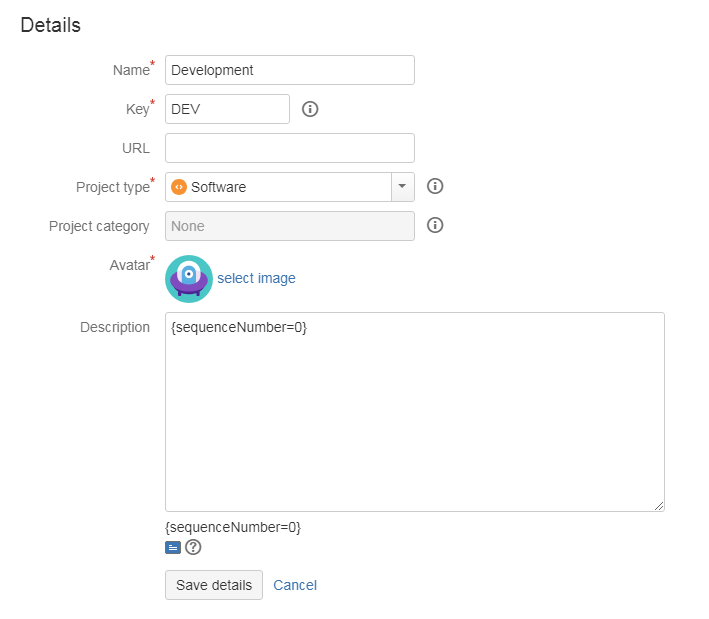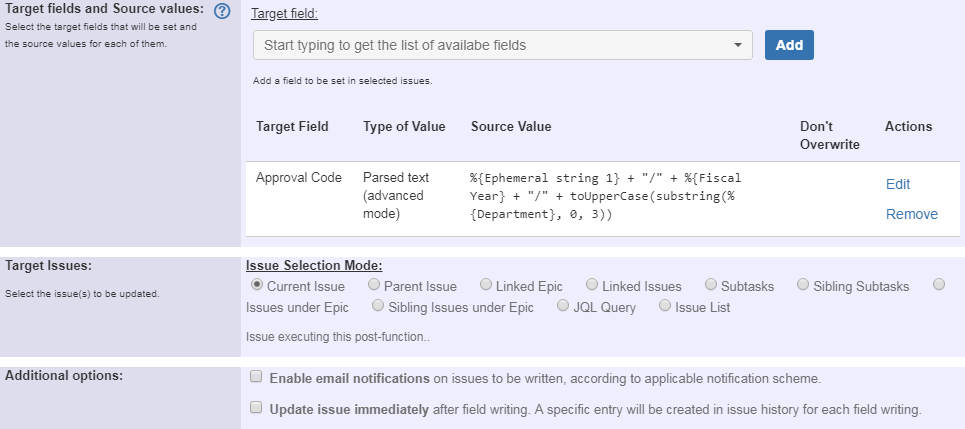Page History
| Section | ||||||||||||||||||||||||||||
|---|---|---|---|---|---|---|---|---|---|---|---|---|---|---|---|---|---|---|---|---|---|---|---|---|---|---|---|---|
|
Features used to implement the example
- Project Properties
- Read a project property
- Mathematical and date-time expression calculator
- Update issue fields
- Set or create project property
Example:
Setting a custom field with project and property and custom fieldsBITTE DIE MAKROS UM NAME DER POST FUNCTION (LINKES MAKRO) UND WEITERE LABELS (RECHTES MAKRO) ERGÄNZEN UND HIER DIE SECTION LÖSCHEN!
Using project properties to calculate custom sequence numbers
In this example, a custom identifier "Approval Code" is added to issues by using a project property and different custom fields.
The code that will be created is a combination of a specific number (sequence number), the fiscal year (custom field) and abbreviation of a department and will look like this:
003/2018-2019/DEV
Configuration items needed are:
- Project property "sequenceNumber"
- Custom Text Field "Department"
- Custom Text Field "Fiscal Year"
- Custom Text Field "Approval Code"
Setting the project property
Setting a project property can be done via the project settings → Details.
A valid expression is: {sequenceNumber=0}
Adding multiple post functions
When executing the transition, the current value of "sequenceNumber" is stored in an ephemeral field with the Read a project property post function.
Name of project property is: sequenceNumber
| Info |
|---|
Ephemeral fields are temporary fields that can be used within a transition, e.g. to cache temporary values. They're cleared when the transition is completed, unless a Inhibit ephemeral fields auto-clearance post function is added to the transition. |
Incrementing the "sequenceNumber" by one is done with a Mathematical and date-time expression calculator post function.
Formula is: {00058} + 1
Note that:
- {00058} is the field code for Ephermeral Number 1
Formatting the "sequenceNumber" is done with a Set a field as a function of other fields post function: This ensures that the sequence number is always a 3 digit number, e.g. "3" is formatted to "003" and "10" to "010".
Setting rules are:
[length(%{00058}) = 1]00%{00058}[length(%{00058}) = 2]0%{00058}[true]%{00058}
Note that:
- %{00058} is the field code for Ephemeral number 1
Finally, the "Approval Code" is composed with an Update issue fields post function.
Text to be parsed (in advanced mode) is: %{00061} + "/" + %{10420} + "/" + toUpperCase(substring(%{10421}, 0, 3))
Note that:
%{00061} is the field code for Ephermeral string 1
- %{10420} is the field code for custom text field "Fiscal Year" (this field code might differ on your instance)
- %{10421} is the field code for custom text field "Department" (this field code might differ on your instance)
In order to keep the "sequenceNumber" in sync, a final Set or create project property post function is added.
Once configured, the transition will look like this:
| Warning |
|---|
When executing this transition, the custom fields "Fiscal Year" and "Department" must not be empty! Ensuring this can be done by using a validator. |
Other examples of that function
| Incoming Links | ||||
|---|---|---|---|---|
| ||||
Related Usage Examples
| Content by Label | ||||
|---|---|---|---|---|
|






